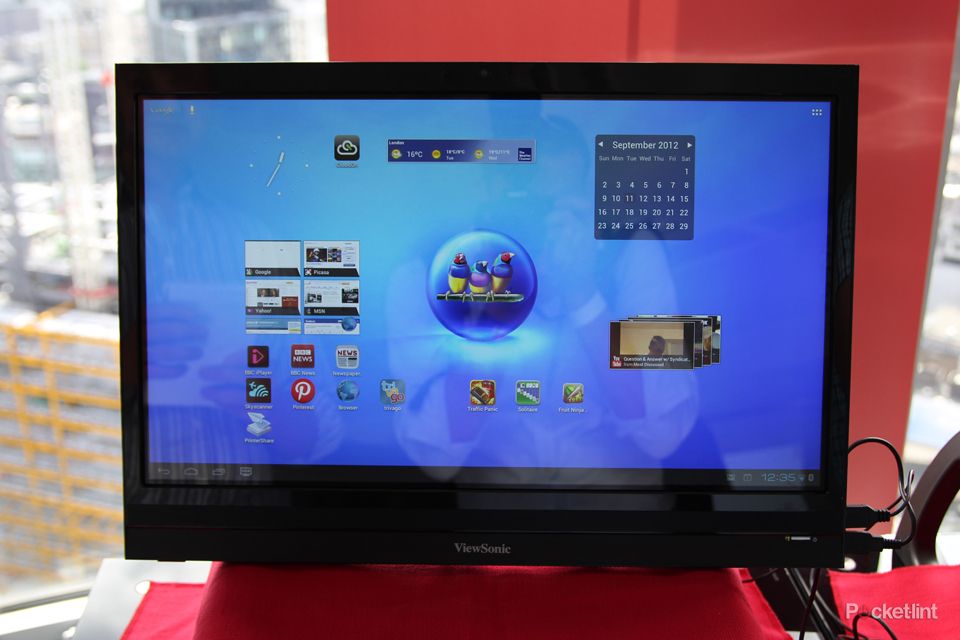The ViewSonic VSD220 is something of an oddity. Pitched as an all in one PC "smart display" it is essentially a monitor - something ViewSonic knows a lot about - with Android stirred into the mix.
ViewSonic has had some success with Android, with a run of tablets and smartphones, but never really hitting the big time. This new move towards a hybrid device looks to be attacking the "home PC" sector. We caught up with the ViewSonic VSD220 at the unveiling in London and had the chance for a quick play with the new device.
It's sold without a keyboard and mouse, so this isn't a PC replacement, but equally, it isn't just a giant tablet. The oddity, perhaps, is that even though this is a 22-inch display, with a 1920 x 1080 pixel resolution, ViewSonic has stuck with some micro connections.
You get two full-sized USB connections, but apart from that you have a microSD card slot: this format is ideal for smartphones, but relatively scarce outside of phones, aside from a few cameras. Why no support for full-sized SD?

The location of card slot is also puzzling, being tucked around the back, rather than easily accessible at the side. This suggests that ViewSonic is eyeing memory expansion rather than hot swapping cards from a digital camera. There is 8GB of internal memory, so perhaps expansion is going to be necessary.
The other connections include an additional Micro-USB and micro HDMI, again, we're not sure why, unless they're simply legacy connections from whatever Android board the VSD220 evolved from.
The display looks colourful and vibrant, although it suffers heavily from reflection. To be fair, we were viewing the VSD220 on the 32nd floor, surrounded by floor-to-ceiling glass, so there was a lot of ambient light - more than you'd find in your home.
Unlike a phone or tablet, there's no auto-brightness here. Instead you'll find an OSD control, rather like a conventional monitor. This will let you change the brightness, contrast and volume, as well as switch over to the HDMI input, to use the display as a monitor.

This isn't a capacitive display, it's resistive. The reason for that is affordability and at this scale is doesn't matter as much as it does on a smaller smartphone. Our exploratory prods resulted in quick responses, so we're happy that the display works as it should.
Sitting under the hood is the OMAP 4430 dual core chipset, with 1GB RAM. That's a reasonable loadout, although not as powerful as some of the latest phones, and it should handle the sorts of tasks you ask of it: browsing the web, playing movies or catchup TV.
The sample movies we watched ran smoothly enough, but the lack of an internet connection meant we couldn't explore too much.
When it comes to practicality, there's a lot that an Android device of this size will do, such as handling BBC iPlayer or Netflix content, or hosting a Skype chat for the whole family to gather around. As it comes with full Google certification, you also get access to the normal Google magic, including your accounts, Maps, Gmail and so on.
The ViewSonic VSD220 runs Android 4.0 Ice Cream Sandwich and there are few tweaks, so it's a pretty native experience. Some changes have been made, as mentioned, to accommodate the screen controls, but that's about it.

Around the back you'll find a VESA mount, so you could attach this to the wall of your kitchen, or use the multi position stand on the rear.
We've mentioned cost and it's worth noting that the affordable price is reflected somewhat in the build. The bezel is a little heavy and the plastics aren't finished in the most premium of fashions, but for £359, it suits the price point.
The ViewSonic VSD220 is an interesting device as an Android home PC, but we can't help feeling that it's still rather niche in its appeal, considering that the phone in your pocket will do exactly the same.

